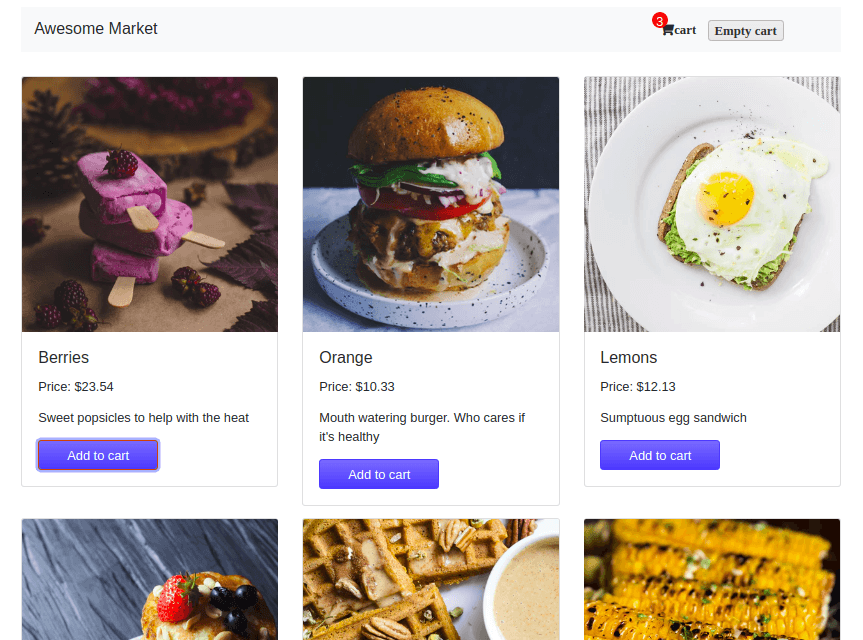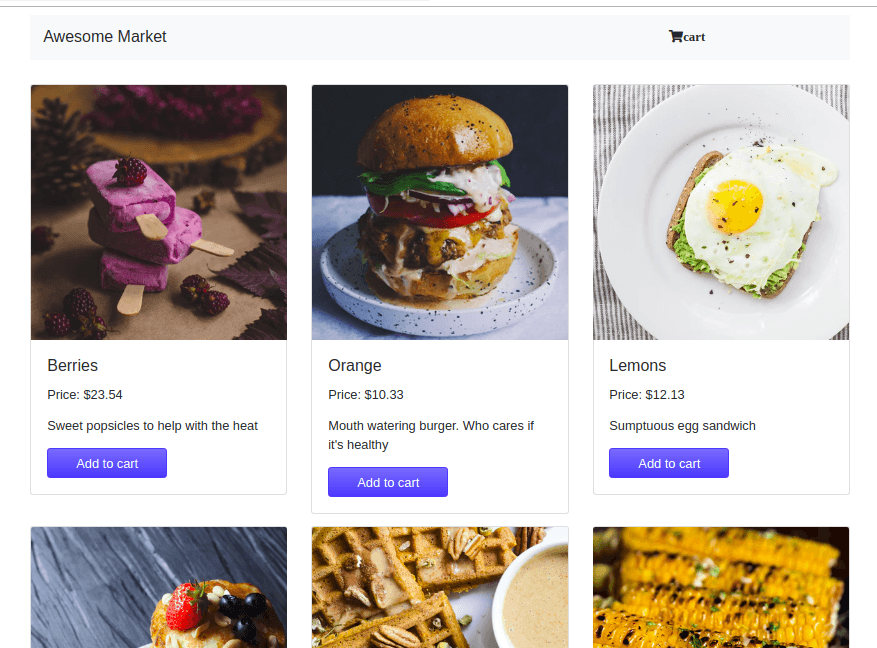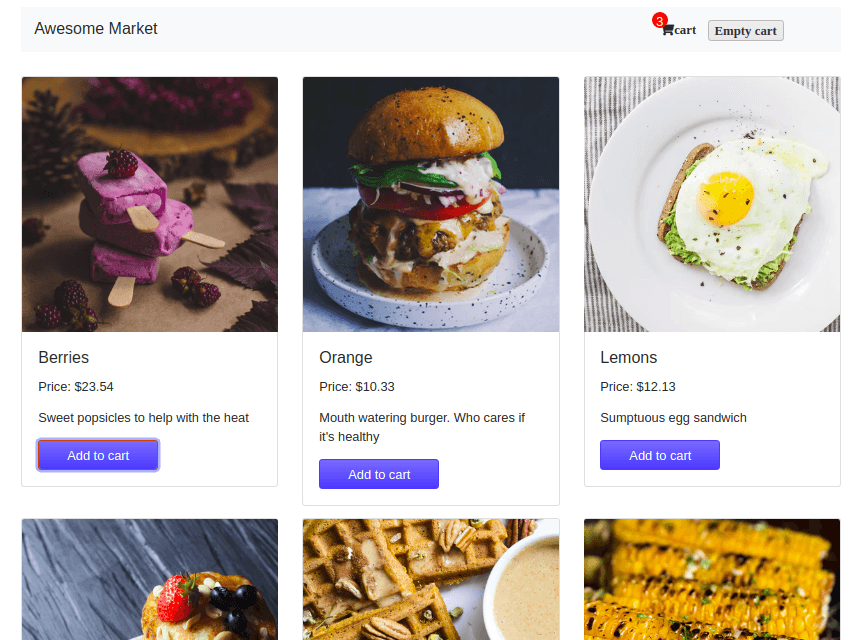在本教程中,我们将使用HTML、CSS、jQuery和Kendo UI提供的一些组件来构建电商APP。在本教程中,我们将构建电子商务应用程序的基本版本。
从头开始构建组件有时会非常耗时,为了方便的处理应用程序,我们将使用Kendo UI组件,这将节省大量时间。
Kendo UI是由Progress的Telerik团队开发的JavaScript库,它能帮助您快速构建Web应用程序的UI。Kendo UI的核心库提供了一系列易于使用的UI组件,例如网格、文本框、数字文本框、图表等,Kendo UI提供了流行的JavaScript库(如jQuery,Angular,React和Vue)的组件。
先决条件
要构建此应用程序,请使用以下一些工具:
Kendo UI
HTML/CSS
jQuery

初始化应用程序
虽然开发功能齐全/可扩展的电子商务应用程序可能会很麻烦,但是实现基本版本很容易创建,我们将使用HTML/CSS, jQuery和Kendo UI创建一个应用。
创建一个名为marketplace的文件夹,并在其中定义此文件夹结构:
marketplace/
css/
styles.css
js/
items.js
functions.js
index.html
对于我们的应用程序,将使用一种非常简单的方法:
定义一个css文件夹来保存样式表。
定义一个保存jQuery函数的js和一个包含市场商品的item.js文件。
最后在文件夹的底部创建一个index.html文件,以用作应用程序的入口点。
首先准备index.html文件来接收和显示内容,在索引文件中,输入以下代码行:
<!– ./index.html –>
<html>
<head>
<title>Awesome Market</title>
<link rel=”stylesheet” href=”css/styles.css”>
<link rel=”stylesheet” href=” https://stackpath.bootstrapcdn.com/bootstrap/4.3.1/css/bootstrap.min.css”>
<link rel=”stylesheet” href=”https://use.fontawesome.com/releases/v5.7.2/css/all.css” integrity=”sha384-fnmOCqbTlWIlj8LyTjo7mOUStjsKC4pOpQbqyi7RrhN7udi9RwhKkMHpvLbHG9Sr” crossorigin=”anonymous”>
</head>
<body>
<main>
<header>
<nav class=”navbar navbar-light bg-light justify-content-between”>
<a class=”navbar-brand”>MarketPlace</a>
<div id=”cart-container”>
<div id=”cart”>
<i class=”fa fa-shopping-cart openCloseCart” style=”margin-right: 10px;” aria-hidden=”true”>cart</i>
<i class=”fas fa-trash-alt” id=”emptyCart”>Empty cart</i> </div>
<span id=”itemCount”></span>
</div>
</nav>
</header>
<div id=”shoppingCart”>
<div id=”cartItemsContainer”>
<h2>Items in your cart</h2>
<i class=”fa fa-times-circle-o fa-3x openCloseCart” aria-hidden=”true”></i>
<div id=”cartItems”></div>
<span id=”cartTotal”></span>
</div>
</div>
<div id=”products” class=”row”> </div>
</main>
<script src=”https://code.jquery.com/jquery-3.3.1.js”
integrity=”sha256-2Kok7MbOyxpgUVvAk/HJ2jigOSYS2auK4Pfzbm7uH60=”
crossorigin=”anonymous”>
</script>
<script src=”js/functions.js”></script>
</body>
</html>
通过CDN导入所有相关资源,资源包括jQuery、Bootstrap和fontawesome,以及自定义样式表。
定义将显示项目的区域。
标题包含当前购物车项目和一个用于清空图表的按钮。
定义div在每次查看时保存图表项。
div为空,将自动从jQuery函数动态注入产品。
导入jQuery和自定义js文件
到目前为止,我们已经定义了一个样式表和一个包含空内容的函数文件,继续填充它们。
打开您的CSS文件并添加文件,并向其中添加以下代码:
// css/styles.css
main {
padding: 10px 0;
width: 1024px;
margin: 0 auto;
}
#cart-container {
float: right;
width: 210px;
position: relative;
}
#itemCount {
position: absolute;
display: none;
top: -10px;
left: -10px;
width: 20px;
height: 20px;
border-radius: 50%;
background: red;
color: white;
text-align: center;
}
nav {
margin-bottom: 30px;
nav ul {
list-style: none;
overflow: auto;
width: 100%;
background: #444444;
}
nav ul li {
float: left;
padding: 5px 20px;
}
nav ul li a {
color: #fff;
text-decoration: none;
}
nav ul li:hover {
color: #444444;
background: #cccccc;
}
nav ul li:hover a {
color: #444444;
}
img {
width: 100%;
}
.item {
width: 31%;
float: left;
margin: 1%;
}
.itemText p {
margin-bottom: 20px;
}
.price-container {
margin-top: 20px;
}
i:hover {
cursor: pointer;
}
#shoppingCart {
top: 0;
left: 0;
height: 100%;
width: 100%;
display: none;
position: absolute;
z-index: 9999;
background: rgba(0, 0, 0, 0.6);
}
#cartItemsContainer {
position: relative;
width: 600px;
left: 50%;
top: 150px;
margin-left: -300px;
padding: 40px;
box-shadow: 0 0 10px black;
background: #e9e9e9;
overflow: auto;
}
#cartItemsContainer i {
position: absolute;
top: 20px;
right: 20px;
}
#cartItemsContainer .itemDetails {
overflow: auto;
width: 100%;
margin-bottom: 40px;
}
#emptyCart {
display: none;
}
#cartItemsContainer .itemImage {
float: left;
width: 260px;
padding: 0 40px;
}
#cartItemsContainer .itemText {
float: right;
width: 260px;
padding: 0 40px;
}
#cartItemsContainer .itemText .price-container {
margin-top: 0;
}
.removeItem {
margin-left: 40px;
}
.col-sm-4 {
margin-bottom: 15px;
}
现在,用产品填充items.js文件,向其添加以下代码:
// js/items.js
[
{
“name”: “Berries”,
“price”: 23.54,
“image”: “https://images.unsplash.com/photo-1488900128323-21503983a07e?ixlib=rb-1.2.1&ixid=eyJhcHBfaWQiOjEyMDd9&auto=format&fit=crop&w=400&h=400&q=80”,
“description”: “Sweet popsicles to help with the heat”
},
{
“name”: “Orange”,
“price”: 10.33,
“image”: “https://images.unsplash.com/photo-1504185945330-7a3ca1380535?ixlib=rb-1.2.1&ixid=eyJhcHBfaWQiOjEyMDd9&auto=format&fit=crop&h=340&w=340&q=80”,
“description”: “Mouth watering burger. Who cares if it’s healthy”
},
{
“name”: “Lemons”,
“price”: 12.13,
“image”: “https://images.unsplash.com/photo-1504382262782-5b4ece78642b?ixlib=rb-1.2.1&ixid=eyJhcHBfaWQiOjEyMDd9&auto=format&fit=crop&w=400&h=400&q=80”,
“description”: “Sumptuous egg sandwich”
},
{
“name”: “Bananas”,
“price”: 10.33,
“image”: “https://images.unsplash.com/photo-1478369402113-1fd53f17e8b4?ixlib=rb-1.2.1&ixid=eyJhcHBfaWQiOjEyMDd9&auto=format&fit=crop&w=400&h=400&q=80”,
“description”: “A great tower of pancakes. Dig in!”
},
{
“name”: “Apples”,
“price”: 10.33,
“image”: “https://images.unsplash.com/photo-1505253304499-671c55fb57fe?ixlib=rb-1.2.1&ixid=eyJhcHBfaWQiOjEyMDd9&auto=format&fit=crop&w=400&h=400&q=80”,
“description”: “Great looking Waffle to start the day”
},
{
“name”: “Sharifa”,
“price”: 10.33,
“image”: “https://images.unsplash.com/photo-1470119693884-47d3a1d1f180?ixlib=rb-1.2.1&auto=format&fit=crop&w=400&h=400&q=80”,
“description”: “What’s greater than 5 minutes with grilled corn”
}
]
现在打开您的functions.js文件,并向其中添加以下代码:
// js/functions.js
function init(){
// read our array of products and display it
$.getJSON( “js/items.js”, function( json ) {
json.forEach(function (item) {
$(“#products”).append(‘<div class=”col-sm-4″><div class=”card”>’ +
‘<img class=”card-img-top” src=”‘ + item.image + ‘”>’ +
‘<div class=”card-body”>’ +
‘<h5 class=”card-title”>’ + item.name + ‘</h5>’ +
‘<p class=”card-text price”>’ + “Price: $” + item.price + ‘</p>’ +
‘<p class=”card-text price”>’ + item.description + ‘</p>’ +
‘<a href=”#” id=”showPopupNotification” class=”add btn btn-primary”>Add to cart</a>’ +
‘</div>’ +
‘</div></div>’);
});
});
}
$(init);
使用jQuery:
从items.js文件中读取内容
构建产品DOM元素
附加并显示在index.html文件中
现在,当您尝试加载index.html时,将看到一个空白屏幕。 那是因为浏览器由于访问控制源而无法读取JSON文件。为了解决这个问题,需要使用http服务器来加载文件。
首先通过在终端中输入以下命令来安装http-server:
npm install -g http-server
安装后,您就可以在系统中的任何地方使用http服务器,现在在终端中输入以下内容来提供文件:
http-server -c-1
现在,当您在浏览器中访问http:// localhost:8080时,您将看到以下内容:

这意味着已经能够阅读和显示产品及其信息,接下来,我们需要编写函数来处理从购物车中添加和删除商品的操作。
打开functions.js并添加以下代码:
// js/functions.js
function init(){
var itemCount = 0;
var priceTotal = 0;
// other code stays same
// Add Item to Cart
$(‘.add’).click(function (){
itemCount ++;
$(‘#itemCount’).text(itemCount).css(‘display’, ‘block’);
$(this).siblings().clone().appendTo(‘#cartItems’).append(‘<button class=”removeItem”>Remove Item</button>’);
// Calculate Total Price
var price = parseInt($(this).siblings().find(‘.price’).text());
priceTotal += price;
$(‘#cartTotal’).text(“Total: $” + priceTotal);
});
// Hide and Show Cart Items
$(‘.openCloseCart’).click(function(){
$(‘#shoppingCart’).toggle();
});
// Empty Cart
$(‘#emptyCart’).click(function() {
itemCount = 0;
priceTotal = 0;
$(‘#itemCount’).css(‘display’, ‘none’);
$(‘#cartItems’).text(”);
$(‘#cartTotal’).text(“Total: $” + priceTotal);
});
// Remove Item From Cart
$(‘#shoppingCart’).on(‘click’, ‘.removeItem’, function(){
$(this).parent().remove();
itemCount –;
$(‘#itemCount’).text(itemCount);
// Remove Cost of Deleted Item from Total Price
var price = parseInt($(this).siblings().find(‘.price’).text());
priceTotal -= price;
$(‘#cartTotal’).text(“Total: €” + priceTotal);
if (itemCount == 0) {
$(‘#itemCount’).css(‘display’, ‘none’);
}
});
}
$(init);
在这里,我们定义了应用程序所需的功能。
使用Click方法,我们将特定元素作为目标,并根据所单击的按钮来更新它们的状态
当用户添加、删除、清空或查看当前购物车时,状态会更改
最后,一旦文件加载到索引页上,我们就使用jQuery的$调用init函数来初始化文件
至此,我们有了一个电子商务应用程序的工作版本,通过Kendo UI添加另一项功能。
使用Kendo UI添加空购物车按钮
您可能已经注意到,当加载页面时,没有显示空购物车。 这是因为我们最初将其设置为从CSS根本不显示。 在本节中我们将:
使用Kendo UI按钮组件显示和设置按钮样式
仅在购物车中至少有一件商品后才显示按钮
我们需要先将Kendo UI导入到项目中,然后才能访问按钮组件。
打开index.html文件,并向其中添加以下代码行:
// ./index.html
<head>
//import kendoui through the cdn in your header
<link rel=”stylesheet” href=”https://kendo.cdn.telerik.com/2019.1.220/styles/kendo.common.min.css”>
<link rel=”stylesheet” href=”https://kendo.cdn.telerik.com/2019.1.220/styles/kendo.rtl.min.css”>
<link rel=”stylesheet” href=”https://kendo.cdn.telerik.com/2019.1.220/styles/kendo.default.min.css”>
<link rel=”stylesheet” href=”https://kendo.cdn.telerik.com/2019.1.220/styles/kendo.mobile.all.min.css”>
<script src=”https://kendo.cdn.telerik.com/2019.1.220/js/kendo.all.min.js”> </script>
</head>
在此文件中,我们仅通过CDN导入Kendo UI。
现在在js文件中初始化函数,打开functions.js文件,并将以下代码添加到其中:
// js/functions.js
// add inside init function
$(“#emptyCart”).kendoButton();
//insert code in bold into this function
$(document).on(“click”, “.add”, function (){
// new code
$(‘#emptyCart’).css(‘display’, ‘inline’);
//other code stays same
这里我们做两件事:
初始化按钮
使用jQuery显示按钮
现在,重新启动服务器,并在浏览器中访问http:// localhost:8080。 将商品添加到购物车后,您将看到按钮显示。
